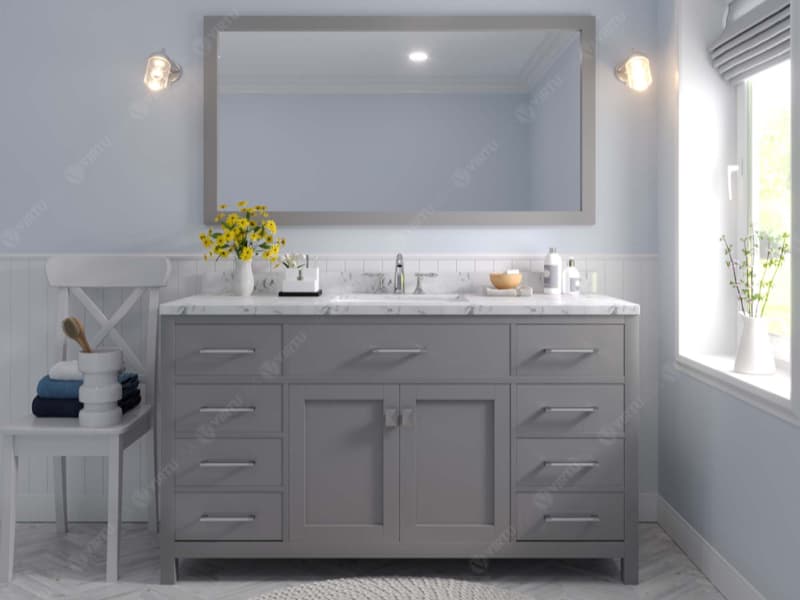The bathrooms in your home reflect your sense of aesthetics, much like the living room, guest room, or primary bedroom. The bathroom vanity you choose dramatically impacts how the room looks. Thanks to contemporary interior designers and service providers in the sector, you can discover inspiration and ideas for your bathroom setup.
When buying a bathroom vanity, consider its size, the plumbing location, and available space. There are stand-alone, wall-mounted, and corner vanities, among other varieties, to choose from. Choose one that fits your bathroom without taking up too much space.
Having solved this headache for myself and many others, I created a guide for settling on a bathroom vanity. This guide should help you in making quality and style-assured vanity selections.

What to consider when buying a bathroom vanity
Before you splash the cash on a bathroom vanity, consider the following:
1. Size
Start with the size before you even search for a new vanity. Everything needs to be able to fit comfortably enough to be used. If you have a shower curtain or liner, the vanity shouldn’t squeeze into it but have enough space.
Is the bathroom narrow, wide, or open? The answer to this question involves looking at the room’s visual appearance and physical size. What size does it seem to be? Is there a precise shape to the space? Is the area more prominent because of the existing vanity, shower, bath, or toilet alcove?
When anything is ill-suited to the area, like the vanity, it will appear to occupy more floor space than it does in the bathroom.
2. Plumbing location
Your vanity needs to fit in the area next to and around those pipes unless you have plans to reroute the plumbing. It must also fit in a space that allows for proper toilet placement and other fixtures.
Each new vanity should have an open space to work around the supply pipes and hoses without pinching or interrupting normal functioning. Moreover, the supply valve should be accessible without any barriers.
Working with the existing layout is far less expensive if you are trying to cut costs. It eliminates the need to hire contractors to reroute the water lines, which is crucial for the vanity’s aesthetics and the design budget.
Choosing a vanity that works with the existing plumbing configuration also reduces the time needed to remodel your bathroom.
3. Space
Examine the available space around the room’s existing plumbing and other elements. The vanity shouldn’t be positioned in a way that restricts movement, prevents access, or makes the space difficult to use.
Nothing should be blocking the cabinet doors or drawers in the bathroom, including the plumbing. While choosing what kind of vanity to purchase, it is essential to account for each challenge. Ensure it allows for proper and reasonable bathroom mirror placement as well.
Bathroom vanity styles
There are many different designs of vanity cabinets to find the ideal fit for your bathroom, even though it might initially seem complex. The key is finding a design that offers the functionality your home needs and the aesthetic that enhances your area.
1. Stand-Alone Installation
Freestanding vanity cabinets, single or double, provide solid storage alternatives in addition to the sink area. These cabinets’ self-supporting construction allows for creative design freedom.
No matter where they are put, these cabinets give storage and utility alternatives, from countertops for décor to drawers and cupboard cubes for organizing.
2. Wall-Mounted Vanity
The simplicity of wall-mounted vanities is their most recognized quality. These floating vanities attach to the wall to conserve space, creating a sleek, modern appearance that expands the bathroom’s overall visual area.
Storage options, including drawers and cabinets, are common on wall-mounted vanities. Wall-mounted vanities are an excellent alternative for bathrooms of all sizes when there is a wall with enough stud support.
3. Corner Vanities
Choose a corner vanity for small bathrooms to save space. Corner vanities are frequently freestanding, mounted on the wall, or a combination of the two.
These awkwardly shaped cabinets, which provide modest storage options, fit all sink configurations, from recessed to vessel sinks.
4. Vanity Selection
Lastly, manufacturers also sell some vanities as two separate pieces: the vanity top and the vanity cabinet. This allows for greater personalization in each home. The top consists of the counter surface, sink(s), and sometimes a short backsplash.
Typically, the vanity top is constructed from a more substantial, water-resistant material like stone, granite, acrylic, ceramic, or granite.
Vanity tops frequently have an overhanging edge that extends beyond the cabinet bases by at least an inch. As you browse, remember that it’s crucial to order the right cabinet-size top.
Conclusion
A little study can assist you in selecting vanities that best suit the look you want for your bathroom. Most bathroom vanities are made to be fixed and secured to the inside wall studs of your home, turning them into permanent pieces of furniture.
Going for a hybrid style that blends old and modern cues is a good idea if you can’t decide. Transitional vanities rank well on the list of options because they are neither too heavy nor too plain.
Depending on your preferences and spending limit, you can choose from vanities that resemble furniture to glass cabinets and European styles.
